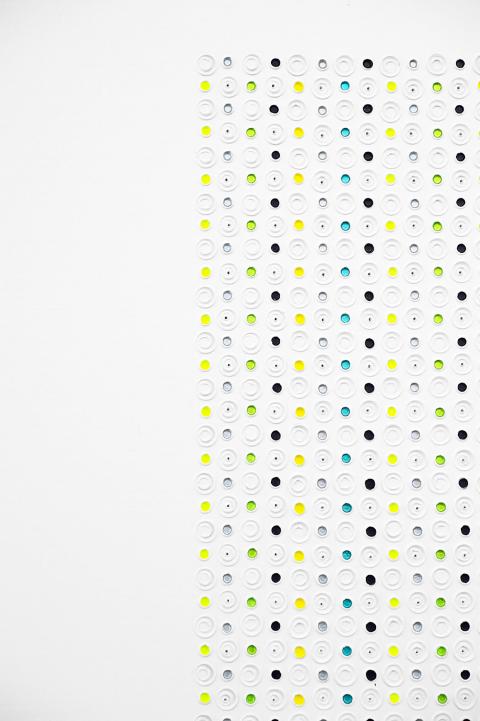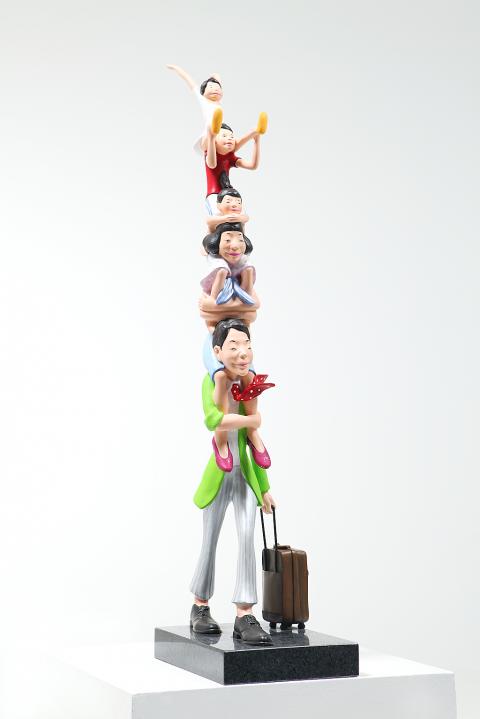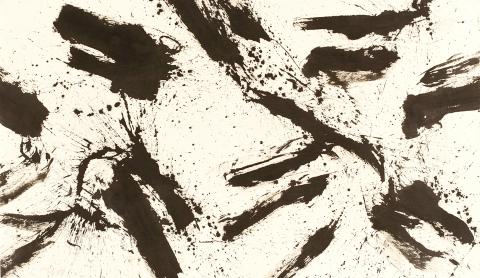We have this perception that South Korean society is full of doom and despair. Office workers slug it out for hours, men must go out drinking with bosses until the wee hours of the morning and women must conform to a rigorous set of beauty standards. That’s why Kim Gyung-min’s sculptures are a breath of fresh air. The mother-of-three makes steel sculptures of happy families doing happy family stuff like riding bicycles, taking the dog out for a walk or playing baseball. Her artwork not only sends happy vibes to those of us who need a little cheering up, but more importantly, it shows that not all art needs to be imbued with deep meaning or strange, dark undertones. Kim’s work is neither satirical nor ironic in any sense — all she wishes is to convey that the pursuit of happiness should be everyone’s life goal. Kim’s sculptures are currently on display at Yi&C Contemporary Art in an exhibition entitled A Journey to Find Happiness (尋找幸福之旅).
Also on display at Yi&C are Kim Ho-deuk’s ink paintings in the solo show, The Mo: Kim Ho-deuk’s Ink Painting (得墨:金浩得墨界). Kim’s paintings essentially resemble blotches and splashes of black ink blown up to fit entire walls, and yet they possess movement. While some have a truncated feel, others are more flowing. The gallery notes describe this effect as “sound ink” — where “the medium of ink expresses sounds audible to the human ear.” They lost me there. Sure, the paintings are pretty, but it’ll take my ears an awful lot of straining before I hear the tumbling sound of a waterfall as the ink cascades down onto the canvas from above.
■ Yi&C Contemporary Art (易雅居當代空間館), 22, Ln 252, Dunhua S Rd Sec 1, Taipei City (台北市敦化南路一段252巷22號), tel: (02) 2781-3131. Open Mondays to Fridays from 10am to 7pm and Saturdays and Sundays from 2pm to 6pm

Photo courtesy of Asia Art Center II
■ Both exhibitions run until Nov. 27
Considerate Creations (溫柔的產出) is a collaborative exhibition at Taipei Artist Village by five artists who are also art administrators at various museums and galleries across Taipei: Chen Hui-chiao (陳慧嶠), Wang Te-yu (王德瑜), Lee Jo-mei (李若玫), Chen S’Han (陳思含) and Wu Hong-hong (吳紅虹). Art administrators work behind the scenes, making sure that exhibitions happen without any hiccups. As such, the exhibition takes a subdued instructional approach, with each artist creating a separate part to form an installation of what appears to be a (very creepy looking) bedroom. For instance, Lee, who is known for drawing on her family photos to create nostalgic montages, here takes an organic approach by using live plants to symbolize some of the more transient things in life, from individual memories to human existence. Wu pieces together old faded letters to achieve a homely feel, while Wang, whose signature alien-inspired “balloon art” has won her plaudits, creates the bedding for the installation. Chen glues a few orange-colored bouncy balls to the bed (because why not?) and finally, Lee sketches some building plans. The shoddy yet perfectionistic nature of the exhibition shows how no matter how hard we work, we might not always achieve what we yearn for.
■ Barry Room, Taipei Artist Village (台北國際藝術村百里廳), 7 Beiping E Rd, Taipei City (台北市北平東路7號), tel: (02) 3393-7377. Open Tuesdays to Sundays from 11am to 9pm

Photo courtesy of Yi&C Contemporary Art
■ Until Nov. 29
Chinese artist Chen Yufan (陳彧凡) who identifies as being both a Daoist and a Zen Buddhist (who knew you could be both?) currently has an exhibition at Asia Art Center II. The self-titled exhibition features some of his minimalistic paintings, sculptures and installations. Chen’s palette is simple — mostly white, black and gray, with a hint of yellow and lime green here and there. The circles on his paintings are perfectly formed, made from tiny holes poked into acrylic paint with a soldering iron. His installations, made with strings and stones, have a meditative, almost literary feel, as if they are trying to tell a story but at the same time, deliberately holding back. Randian magazine (燃點) describes Chen’s work as “rich in [literary] narratives and Eastern philosophies,” as well as occupying a “mindful space of Daoism and Zen.”
■ Asia Art Center II (亞洲藝術中心二館), 93, Lequn 2nd Road, Taipei City (台北市樂群二路93號), tel: (02) 8502-7939. Open Tuesdays to Sundays from 10am to 6:30pm

Photo courtesy of Yi&C Contemporary Art
■ Until Dec. 6
Currently on display at Art Issue Projects are the works of the late Korean-American artist Paik Nam-june who pioneered the field of video art. The exhibition, which is aptly named Videology (意識錄), showcases some of Paik’s finest and most thought-provoking pieces including televisions sculpted to resemble other objects and his neon-lit signs which alluded to America’s mass consumerism. Paik, who grew up in South Korea, but also lived in Japan and Germany before settling in New York, showed influences from various cultures in his artwork. A year before his death, in 2005, Paik created Ommah (which means “mother” in Korean), a video installation where a television hidden underneath a traditional, transparent silk robe, screened images of happy children dressed in traditional garments playing American video games.
■ Art Issue Projects (藝術計劃), 32, Ln 407, Tiding Blvd Sec 2, Taipei City (台北市堤頂大道二段407巷32號), tel: (02) 2659-7737. Open Tuesdays to Sundays from 11am to 6pm
■ Until Jan. 17

In the March 9 edition of the Taipei Times a piece by Ninon Godefroy ran with the headine “The quiet, gentle rhythm of Taiwan.” It started with the line “Taiwan is a small, humble place. There is no Eiffel Tower, no pyramids — no singular attraction that draws the world’s attention.” I laughed out loud at that. This was out of no disrespect for the author or the piece, which made some interesting analogies and good points about how both Din Tai Fung’s and Taiwan Semiconductor Manufacturing Co’s (TSMC, 台積電) meticulous attention to detail and quality are not quite up to

Chinese Nationalist Party (KMT) Chairman Eric Chu (朱立倫) hatched a bold plan to charge forward and seize the initiative when he held a protest in front of the Taipei City Prosecutors’ Office. Though risky, because illegal, its success would help tackle at least six problems facing both himself and the KMT. What he did not see coming was Taipei Mayor Chiang Wan-an (將萬安) tripping him up out of the gate. In spite of Chu being the most consequential and successful KMT chairman since the early 2010s — arguably saving the party from financial ruin and restoring its electoral viability —

It is one of the more remarkable facts of Taiwan history that it was never occupied or claimed by any of the numerous kingdoms of southern China — Han or otherwise — that lay just across the water from it. None of their brilliant ministers ever discovered that Taiwan was a “core interest” of the state whose annexation was “inevitable.” As Paul Kua notes in an excellent monograph laying out how the Portuguese gave Taiwan the name “Formosa,” the first Europeans to express an interest in occupying Taiwan were the Spanish. Tonio Andrade in his seminal work, How Taiwan Became Chinese,

Toward the outside edge of Taichung City, in Wufeng District (霧峰去), sits a sprawling collection of single-story buildings with tiled roofs belonging to the Wufeng Lin (霧峰林家) family, who rose to prominence through success in military, commercial, and artistic endeavors in the 19th century. Most of these buildings have brick walls and tiled roofs in the traditional reddish-brown color, but in the middle is one incongruous property with bright white walls and a black tiled roof: Yipu Garden (頤圃). Purists may scoff at the Japanese-style exterior and its radical departure from the Fujianese architectural style of the surrounding buildings. However, the property